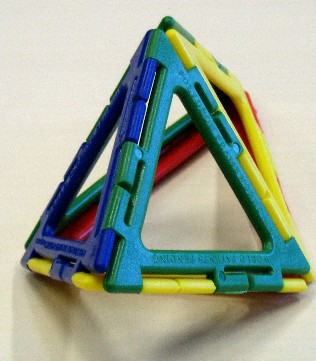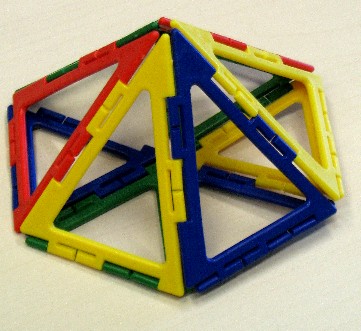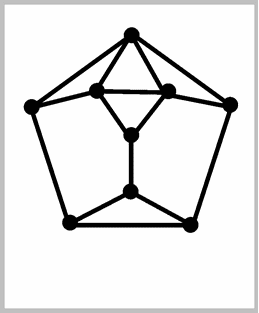



 Here ares some examples. The empty red triangles in the third example still count as faces.
Here ares some examples. The empty red triangles in the third example still count as faces.
For the moment, let us define polyhedra as follows: A polyhedron is a three-dimensional object created by putting flat polygons together such that two polygons are joined by a common edge, and every edge bounds two polygons. Obviously every polyhedron could also be viewed as a graph, since we have vertices---the vertices of the polygons--- that are connected by edges. The degree of a vertex in the polygon is the number of edges it is incident with. It is the same as the degree in the graph-theoretical sense.
Let us call the degree of a face the number of edges bounding it. For some famous polyhedra, all faces have the same shape---they are regular n-gons for a fixed value of n. This is true for the five Platonic Solids, where all faces are regular polygons of only one shape, and every vertex has the same degree.
| Name (click for animation) | Tetrahedron | Cube | Octahedron | Dodecahedron | Icosahedron |
| Look |

|

|

|

|

|
| degree (number of faces or edges) at each vertex | 3 | 3 | 4 | 3 | 5 |
| V=number of vertices | 4 | 8 | 6 | 20 | 12 |
| E=number of edges | 6 | 12 | 12 | 30 | 30 |
| F=number of faces | 4 | 6 | 8 | 12 | 20 |
| degree (number of edges) of each face | 3 | 4 | 3 | 5 | 3 |
Since polyhedra are also graph, we know from the graph page:
Therefore the number of edges doesn't have to be counted but can be computed from the other parameters. In particular, since the graphs of Platonic solids are r-regular, (all vertices have the same degree r) we know that 2E=rV for them, i.e. E=rV/2. For instance, for the cube we have 3·8/2 edges, for the icosahedron we have 5·12/2 edges.
We want to be able to compute the number of edges also for non-Platonic polyhedra, i.e. for nonregular graphs. For this purpose we use the abbreviation of Vn for the number of vertices of degree n in every polyhedron, and in the same way Fn for the number of faces that are n-gons (bounded by n edges). Note that no vertex can have degree 2 in a polyhedron (Why not?)(although in a general graph it can) and of course, there are no 2-gons. Therefore V2 and F2 are always both equal to 0. Of course, since every vertex and every face have exactly one degree, V = V3+V4+V5+... and F = F3+F4+F5+... .
Now the sum of all degrees of all vertices equals 3·V3 +4·V4+5·V5+ .... . Therefore the above remark can be restated as:
We have a similar theorem, this time adding the degrees of the faces. Recall that the degree of a face is the number of edges bounding it.
Check the previous two Theorems in the data shown below for some polyhedra, and the data for the five platonic solids. Do you see another pattern? Make a table of vertex number versus face number for polyhedra with 12 edges.
| Name | doghouse | double pyramid | Napoleon's hat | UFO | ||
| Look | 
|

|

|

|

|
 The base is considered to be one 6-gon, instead of six triangles. |
| V3,V4,V5.... | 6,3 | 2,3 | 2,2,2 | 2,5 | 0,6,0,2 | 6,0,0,1 |
| V=number of vertices | 9 | 5 | 6 | 7 | 8 | 7 |
| E=number of edges | 15 = (3·6+4·3)/2 = (3·5+4·0+5·3)/2 | 9 = (3·2+4·3)/2 = 3·6/2 | 12 = (3·2+4·2+5·2)/2 = 3·8/2 | 13 = (3·2+4·5)/2 = (3·6+4·2)/2 | 18 = (3·0+4·6+5·0+6·2)/2 = 3·12/2 | 12 = (3·6+4·0+5·0+6·1)/2 =(3·6+4·0+5·0+6·1)/2 |
| F=number of faces | 8 | 6 | 8 | 8 | 12 | 7 |
| F3,F4,F5,... | 5,0,3 | 6 (all triangles) | 8 (all triangles) | 6,2 | 12 (all triangles) | or: 6,0,0,1 |
| nonconvex | self-dual |
A graph is plane if it is drawn in such a way that different edges don't meet each other, except at vertices they have in common, of course, where it is unavoidable. Note that edges don't have to be straight lines here, just curves, although with a little effort, by redrawing the location of the vertices, we can draw every plane graph even with straight edges in this way. Below three examples are given:
 |
 |
 |
The edges of any plane graph cut the plane into pieces. These are called the regions or faces of the plane graph. One of them is unbounded, the outer region.
Since V-E+R didn't change during the steps in (1) and (2), V-E+R=2 also for the initial graph.
 This formula is not true for non-connected plane graphs, see the graph to the right,
which has 8 vertices, 8 edges, and 3 faces.
This formula is not true for non-connected plane graphs, see the graph to the right,
which has 8 vertices, 8 edges, and 3 faces.
Graphs may be drawn in different ways, some of them plane, some not. Thus we call a graph planar if it allows a plane representation.
Since polyhedra are 3-dimensional, and as such rather difficult to display, we aim at a good 2-dimensional visualization. Actually, by making all faces transparent, we "see" the graph. Vertices and edges are clearly visible, but not the faces. We would like to "see these faces as well. A good plane projection of a polyhedron is a plane drawing of its graph in such a way that the regions of the graph correspond exactly to the faces of the polyhedron. The "good" should remind us that we require more than just the graph made plane.